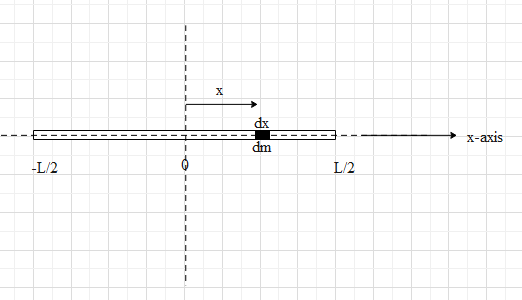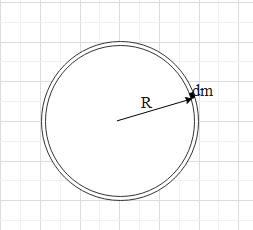
If ${{I}_{1}}$ is the moment of inertia of a thin rod about an axis perpendicular to its length and passing through its centre of mass, and ${{I}_{2}}$ is the moment of inertia (about central axis) of the ring formed by bending the rod, then
$\text{A}\text{. }{{I}_{1}}:{{I}_{2}}=1:1$
$\text{B}\text{. }{{I}_{1}}:{{I}_{2}}={{\pi }^{2}}:3$
$\text{C}\text{. }{{I}_{1}}:{{I}_{2}}=\pi :4$
$\text{D}\text{. }{{I}_{1}}:{{I}_{2}}=3:5$
Answer
570.6k+ views
Hint: Consider a small element of dm mass and of dx length, which is at distance of x from the centre of the rod. Use the formula $I=m{{r}^{2}}$. Assume that the rod has uniform mass density and find a relation between dm and dx. Then integrate for the limits from $x=-\dfrac{L}{2}$ to $x=\dfrac{L}{2}$. Repeat the same procedure for the ring.
Formula used:
$I=m{{r}^{2}}$
Complete step-by-step answer:
Let us first derive the expression for both the moments of inertia and then divide both to find the ratio.
Let the mass of the rod be M and length of the rod be L.
For the moment of inertia (${{I}_{1}}$) of the rod about an axis perpendicular to its length and passing through its centre of mass, consider a small element of mass dm. Let the length of this dm mass be dx and let it be at a distance x from the centre of mass of the rod. Assume that the mass of the rod is uniformly distributed and hence the centre of mass will be the centre (midpoint) of the rod.

Centre of mass is defined as the product of the mass of the element and its perpendicular distance from the axis of rotation. Here the perpendicular is equal to x. Let the moment of inertia of this element be $d{{I}_{1}}$.
Therefore, $d{{I}_{1}}=dm{{x}^{2}}$ …. (i).
The mass of the rod is uniformly distributed, hence its mass density will be constant.
Therefore, $\dfrac{dm}{dx}=\dfrac{M}{L}$.
$\Rightarrow dm=\dfrac{M}{L}dx$
Substitute the value of dm in equation (i).
$\Rightarrow d{{I}_{1}}=\dfrac{M}{L}{{x}^{2}}dx$.
Integrate both sides and keep the limits of x from $-\dfrac{L}{2}$ to $\dfrac{L}{2}$.
$\Rightarrow \int{d{{I}_{1}}}=\int\limits_{-\dfrac{L}{2}}^{\dfrac{L}{2}}{\dfrac{M}{L}{{x}^{2}}dx}$
$\Rightarrow {{I}_{1}}=\dfrac{M}{L}\int\limits_{-\dfrac{L}{2}}^{\dfrac{L}{2}}{{{x}^{2}}dx}$
$\Rightarrow {{I}_{1}}=\dfrac{M}{L}\left. \dfrac{{{x}^{3}}}{3} \right|_{-\dfrac{L}{2}}^{\dfrac{L}{2}}$
$\Rightarrow {{I}_{1}}=\dfrac{M}{L}\left( \dfrac{{{\left( \dfrac{L}{2} \right)}^{3}}}{3}-\dfrac{{{\left( -\dfrac{L}{2} \right)}^{3}}}{3} \right)$
$\Rightarrow {{I}_{1}}=\dfrac{M}{L}\left( \dfrac{{{L}^{3}}}{8\times 3}-\dfrac{-{{L}^{3}}}{8\times 3} \right)$
$\Rightarrow {{I}_{1}}=\dfrac{M}{L}\left( \dfrac{{{L}^{3}}}{8\times 3}+\dfrac{{{L}^{3}}}{8\times 3} \right)=\dfrac{M}{L}\left( \dfrac{2{{L}^{3}}}{8\times 3} \right)$
$\Rightarrow {{I}_{1}}=\dfrac{M}{L}\left( \dfrac{{{L}^{3}}}{4\times 3} \right)=\dfrac{M{{L}^{2}}}{12}$ ….. (ii).
Now the rod is bent to form a circular ring of radius R. Here,$L=2\pi R$ …… (iii).
Now, the axis of rotation is passing through the centre of the ring and is perpendicular to the plane of the ring.
Again consider the mass of the ring. In this case, this dm mass will be at a perpendicular distance of R from the centre.

Therefore, $d{{I}_{2}}=dm{{R}^{2}}$
Therefore, ${{I}_{2}}=\int{d{{I}_{2}}}=\int{dm{{R}^{2}}}$
Here, R is constant because the radius of the ring is fixed.
Therefore, ${{I}_{2}}={{R}^{2}}\int{dm}=M{{R}^{2}}$ …… (iv).
Divide equation (i) and equation (iv).
Hence, we get
$\dfrac{{{I}_{1}}}{{{I}_{2}}}=\dfrac{\dfrac{M{{L}^{2}}}{12}}{M{{R}^{2}}}=\dfrac{{{L}^{2}}}{12{{R}^{2}}}$.
Substitute the value of L from equation (iii).
$\Rightarrow \dfrac{{{I}_{1}}}{{{I}_{2}}}=\dfrac{{{(2\pi R)}^{2}}}{12{{R}^{2}}}=\dfrac{4{{\pi }^{2}}{{R}^{2}}}{12{{R}^{2}}}=\dfrac{{{\pi }^{2}}}{3}$
$\Rightarrow {{I}_{1}}:{{I}_{2}}={{\pi }^{2}}:3$
So, the correct answer is “Option B”.
Note: Note that it is not mentioned in the question, but still we have assumed that the rod has a uniform mass density. If the mass has a non-uniform density then the answer will be different. This means that $\dfrac{dm}{dx}$ is not a constant value. Then we must know that variation of mass with respect to the position.
Formula used:
$I=m{{r}^{2}}$
Complete step-by-step answer:
Let us first derive the expression for both the moments of inertia and then divide both to find the ratio.
Let the mass of the rod be M and length of the rod be L.
For the moment of inertia (${{I}_{1}}$) of the rod about an axis perpendicular to its length and passing through its centre of mass, consider a small element of mass dm. Let the length of this dm mass be dx and let it be at a distance x from the centre of mass of the rod. Assume that the mass of the rod is uniformly distributed and hence the centre of mass will be the centre (midpoint) of the rod.

Centre of mass is defined as the product of the mass of the element and its perpendicular distance from the axis of rotation. Here the perpendicular is equal to x. Let the moment of inertia of this element be $d{{I}_{1}}$.
Therefore, $d{{I}_{1}}=dm{{x}^{2}}$ …. (i).
The mass of the rod is uniformly distributed, hence its mass density will be constant.
Therefore, $\dfrac{dm}{dx}=\dfrac{M}{L}$.
$\Rightarrow dm=\dfrac{M}{L}dx$
Substitute the value of dm in equation (i).
$\Rightarrow d{{I}_{1}}=\dfrac{M}{L}{{x}^{2}}dx$.
Integrate both sides and keep the limits of x from $-\dfrac{L}{2}$ to $\dfrac{L}{2}$.
$\Rightarrow \int{d{{I}_{1}}}=\int\limits_{-\dfrac{L}{2}}^{\dfrac{L}{2}}{\dfrac{M}{L}{{x}^{2}}dx}$
$\Rightarrow {{I}_{1}}=\dfrac{M}{L}\int\limits_{-\dfrac{L}{2}}^{\dfrac{L}{2}}{{{x}^{2}}dx}$
$\Rightarrow {{I}_{1}}=\dfrac{M}{L}\left. \dfrac{{{x}^{3}}}{3} \right|_{-\dfrac{L}{2}}^{\dfrac{L}{2}}$
$\Rightarrow {{I}_{1}}=\dfrac{M}{L}\left( \dfrac{{{\left( \dfrac{L}{2} \right)}^{3}}}{3}-\dfrac{{{\left( -\dfrac{L}{2} \right)}^{3}}}{3} \right)$
$\Rightarrow {{I}_{1}}=\dfrac{M}{L}\left( \dfrac{{{L}^{3}}}{8\times 3}-\dfrac{-{{L}^{3}}}{8\times 3} \right)$
$\Rightarrow {{I}_{1}}=\dfrac{M}{L}\left( \dfrac{{{L}^{3}}}{8\times 3}+\dfrac{{{L}^{3}}}{8\times 3} \right)=\dfrac{M}{L}\left( \dfrac{2{{L}^{3}}}{8\times 3} \right)$
$\Rightarrow {{I}_{1}}=\dfrac{M}{L}\left( \dfrac{{{L}^{3}}}{4\times 3} \right)=\dfrac{M{{L}^{2}}}{12}$ ….. (ii).
Now the rod is bent to form a circular ring of radius R. Here,$L=2\pi R$ …… (iii).
Now, the axis of rotation is passing through the centre of the ring and is perpendicular to the plane of the ring.
Again consider the mass of the ring. In this case, this dm mass will be at a perpendicular distance of R from the centre.

Therefore, $d{{I}_{2}}=dm{{R}^{2}}$
Therefore, ${{I}_{2}}=\int{d{{I}_{2}}}=\int{dm{{R}^{2}}}$
Here, R is constant because the radius of the ring is fixed.
Therefore, ${{I}_{2}}={{R}^{2}}\int{dm}=M{{R}^{2}}$ …… (iv).
Divide equation (i) and equation (iv).
Hence, we get
$\dfrac{{{I}_{1}}}{{{I}_{2}}}=\dfrac{\dfrac{M{{L}^{2}}}{12}}{M{{R}^{2}}}=\dfrac{{{L}^{2}}}{12{{R}^{2}}}$.
Substitute the value of L from equation (iii).
$\Rightarrow \dfrac{{{I}_{1}}}{{{I}_{2}}}=\dfrac{{{(2\pi R)}^{2}}}{12{{R}^{2}}}=\dfrac{4{{\pi }^{2}}{{R}^{2}}}{12{{R}^{2}}}=\dfrac{{{\pi }^{2}}}{3}$
$\Rightarrow {{I}_{1}}:{{I}_{2}}={{\pi }^{2}}:3$
So, the correct answer is “Option B”.
Note: Note that it is not mentioned in the question, but still we have assumed that the rod has a uniform mass density. If the mass has a non-uniform density then the answer will be different. This means that $\dfrac{dm}{dx}$ is not a constant value. Then we must know that variation of mass with respect to the position.
Recently Updated Pages
Why are manures considered better than fertilizers class 11 biology CBSE

Find the coordinates of the midpoint of the line segment class 11 maths CBSE

Distinguish between static friction limiting friction class 11 physics CBSE

The Chairman of the constituent Assembly was A Jawaharlal class 11 social science CBSE

The first National Commission on Labour NCL submitted class 11 social science CBSE

Number of all subshell of n + l 7 is A 4 B 5 C 6 D class 11 chemistry CBSE

Trending doubts
What is meant by exothermic and endothermic reactions class 11 chemistry CBSE

10 examples of friction in our daily life

One Metric ton is equal to kg A 10000 B 1000 C 100 class 11 physics CBSE

1 Quintal is equal to a 110 kg b 10 kg c 100kg d 1000 class 11 physics CBSE

Difference Between Prokaryotic Cells and Eukaryotic Cells

What are Quantum numbers Explain the quantum number class 11 chemistry CBSE




